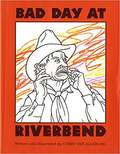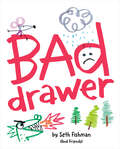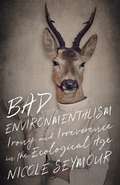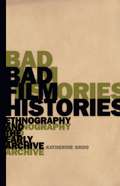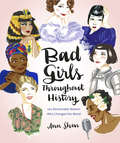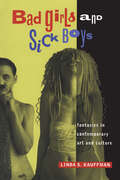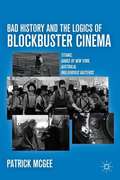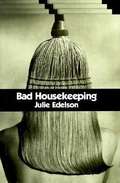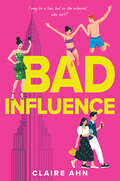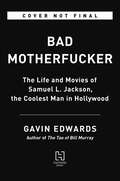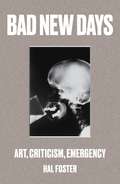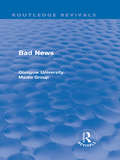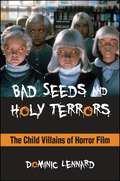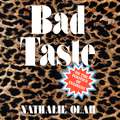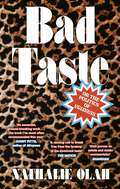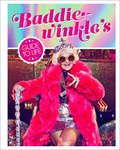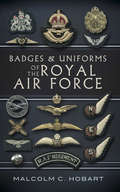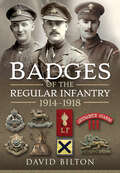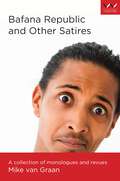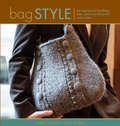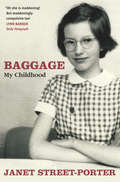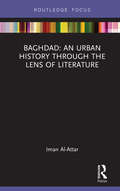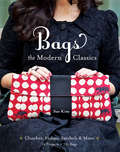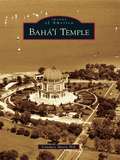- Table View
- List View
Bad Day At Riverbend
by Chris Van AllsburgVan Allsburg cuts loose with this inventive spoof that will keep readers guessing right up to the end of what the whole slimy shining thing is. Van Allsburg clearly had fun with this one, and readers likely will too.
Bad Drawer
by Seth Fishman&“The Stone Soup of collaborative creativity—eight thumbs up!&”—Jessica Love, author of Julián Is a Mermaid"Bad Drawer is inspiring for every kind of drawer, and it is such a fun, creative way to show what can happen when we work together with our friends." —Nathan Pyle, #1 New York Times bestselling creator of Strange Planet A hilarious and gorgeous picture book by A Hundred Billion Trillion Stars author Seth Fishman, following a bad drawer who works together with his friends to help bring his wildest stories to life.Seth has a super fantastic story in his head. A story so completely awesome and unbelievably amazing that he needs to get it out on paper and share it with the world right away. There's only one problem: He's a bad drawer. Like, really bad. He's tried and tried, but his illustrations are never quite like he imagined when they actually land on the page.But he has an idea that might fix things: What if his friends help him bring his story to life? A delightful picture book featuring work from award-winning illustrators Jessixa Bagley, Armand Baltazar, Anna Bond, Travis Foster, Jessica Hische, Tillie Walden, and Ethan Young, Bad Drawer will make readers laugh out loud and embrace their flaws -- while also having quite a bit of fun in the process.
Bad Environmentalism: Irony and Irreverence in the Ecological Age
by Nicole SeymourTraces a tradition of ironic and irreverent environmentalism, asking us to rethink the movement&’s reputation for gloom and doomActivists today strive to educate the public about climate change, but sociologists have found that the more we know about alarming issues, the less likely we are to act. Meanwhile, environmentalists have acquired a reputation as gloom-and-doom killjoys. Bad Environmentalism identifies contemporary texts that respond to these absurdities and ironies through absurdity and irony—as well as camp, frivolity, irreverence, perversity, and playfulness. Nicole Seymour develops the concept of &“bad environmentalism&”: cultural thought that employs dissident affects and sensibilities to reflect critically on our current moment and on mainstream environmental activism. From the television show Wildboyz to the short film series Green Porno, Seymour shows that this tradition of thought is widespread—spanning animation, documentary, fiction film, performance art, poetry, prose fiction, social media, and stand-up comedy since at least 1975. Seymour argues that these texts reject self-righteousness and sentimentality, undercutting public negativity toward activism and questioning basic environmentalist assumptions: that love and reverence are required for ethical relationships with the nonhuman and that knowledge is key to addressing problems like climate change.Funny and original, Bad Environmentalism champions the practice of alternative green politics. From drag performance to Indigenous comedy, Seymour expands our understanding of how environmental art and activism can be pleasurable, even in a time of undeniable crisis.
Bad Film Histories: Ethnography and the Early Archive
by Katherine GrooA daring, deep investigation into ethnographic cinema that challenges standard ways of writing film history and breaks important new ground in understanding archives Bad Film Histories is a vital work that unsettles the authority of the archive. Katherine Groo daringly takes readers to the margins of the film record, addressing the undertheorization of film history and offering a rigorous corrective. Taking ethnographic cinema as a crucial case study, Groo challenges standard ways of thinking and writing about film history and questions widespread assumptions about what film artifacts are and what makes them meaningful. Rather than filling holes, Groo endeavors to understand the imprecisions and absences that define film history and its archives. Bad Film Histories draws on numerous works of ethnographic cinema, from Edward S. Curtis&’s In the Land of the Head Hunters, to a Citroën-sponsored &“croisière&” across Africa, to the extensive archives of the Maison Lumière and the Musée Albert-Kahn, to dozens of expedition films from the 1910s and 1920s. The project is deeply grounded in poststructural approaches to history, and throughout Groo draws on these frameworks to offer innovative and accessible readings that explain ethnographic cinema&’s destabilizing energies.As Groo describes, ethnographic works are mostly untitled, unauthored, seemingly infinite in number, and largely unrestored even in their digital afterlives. Her examination of ethnographic cinema provides necessary new thought for both film scholars and those who are thrilled by cinema&’s boundless possibilities. In so doing, she boldly reexamines what early ethnographic cinema is and how these films produce meaning, challenging the foundations of film history and prevailing approaches to the archive.
Bad Girls Throughout History: 100 Remarkable Women Who Changed the World
by Ann ShenBad Girls Throughout History: 100 Remarkable Women Who Changed the World delivers a empowering book for women and girls of all ages, featuring 100 women who made history and made their mark on the world, it's a best-selling book you can be proud to display in your home.The 100 revolutionary women highlighted in this gorgeously illustrated book were bad in the best sense of the word: they challenged the status quo and changed the rules for all who followed. Explored in this history book, include:• Aphra Behn, first female professional writer.• Sojourner Truth, women's rights activist and abolitionist.• Ada Lovelace, first computer programmer.• Marie Curie, first woman to win the Nobel Prize.• Joan Jett, godmother of punk.From pirates to artists, warriors, daredevils, women in science, activists, and spies, the accomplishments of these incredible women who dared to push boundaries vary as much as the eras and places in which they effected change. Featuring bold watercolor portraits and illuminating essays by Ann Shen, Bad Girls Throughout History is a distinctive, gift-worthy tribute to rebel girls everywhere.A lovely gift for teen girls, stories to share with a young girl at bedtime, or a book to display on a coffee table, everyone will enjoy learning about and celebrating the accomplishments of these phenomenal women.
Bad Girls and Sick Boys: Fantasies in Contemporary Art and Culture
by Linda S. KauffmanLinda S. Kauffman turns the pornography debate on its head with this audacious analysis of recent taboo-shattering fiction, film, and performance art. Investigating the role of fantasy in art, politics, and popular culture, she shows how technological advances in medicine and science (magnetic resonance imaging, computers, and telecommunications) have profoundly altered our concepts of the human body. Cyberspace is producing new forms of identity and subjectivity. The novelists, filmmakers, and performers in Bad Girls and Sick Boys are the interpreters of these brave new worlds, cartographers who are busy mapping the fin-de-millennium environment that already envelops us.Bad Girls and Sick Boys offers a vital and entertaining tour of the current cultural landscape. Kauffman boldly connects the dots between the radical artists who shatter taboos and challenge legal and aesthetic conventions. She links writers like John Hawkes and Robert Coover to Kathy Acker and William Vollmann; filmmakers like Ngozi Onwurah and Isaac Julien to Brian De Palma and Gus Van Sant; and performers like Carolee Schneemann and Annie Sprinkle to the visual arts. Kauffman's lively interviews with J. G. Ballard, David Cronenberg, Bob Flanagan, and Orlan add an extraordinary dimension to her timely and convincing argument.
Bad History and the Logics of Blockbuster Cinema
by Patrick McgeeIn his latest book, Patrick McGee argues for the political and social significance of mass culture through the interpretation of four recent big-budget movies: T itanic, Gangs of New York, Australia, and Inglourious Basterds. Through philosophical and historical contextualization, he reveals the logic of what appears on the screen, a logic that shows how these films both represent and distort the historical record in order to articulate a truth that challenges conventional history as a discipline. Counterdisciplinary in its method, this exciting work asserts that no movie can ever be reduced to the absolutely authentic or the absolutely inauthentic.
Bad Housekeeping: A Novel
by Julie EdelsonCee has moved from NYC to North Carolina where she has divorced her husband for carpeting their Victorian home (surprise!) in orange shag. Now she has accepted a job painting a mural in a bar to try to help her daughter's wayward friend, Fawne (who wants to be called "Fauve"), and ends up getting less help and more trouble than she bargained for. The bough breaks when the truth is discovered, that Cee's daughter Ariel is neck-deep in alcoholism. The girls' troubles are more poignant for Cee because she was helped through her own teenage crises by the brazen eccentricities of her old Brooklyn girlfriend, Elspeth, who makes an appearance at the end of the novel, resembling "a tonsured mole."
Bad Influence
by Claire AhnIn this contemporary YA novel, high school student Charlotte Goh is an aspiring Asian American fashion influencer desperately trying to lift her family out of hardship, only to find it may come at a cost higher than any Chanel bag.Seventeen-year-old Charlotte Goh is juggling two very different personas: the dutiful Korean daughter, and the hustling NYC fashion influencer. Her best friend Steven scoffs at her ambition, but she secretly hopes that her posts will help financially support her struggling family. Then one night, after posting about a racist experience she had at an influencer event, Charlotte finds herself going viral and garnering the fame she&’s always craved. And as much as she doesn&’t want her newfound popularity to change her, she can&’t help but be swept away by the exciting perks: chic new friends, the attention of one of Hollywood&’s hottest heartthrobs, and a slew of companies clamoring to sponsor her.But as she falls deeper into the influencer world, she finds that she may have to sacrifice more than she bargained for—including her unexpected new feelings for Steven. Will Charlotte be able to stay true to herself, or will she lose the things that are most important to her?
Bad Motherfucker: The Life and Movies of Samuel L. Jackson, the Coolest Man in Hollywood
by Gavin EdwardsA fascinating exploration and celebration of the life and work of the coolest man in Hollywood, Samuel L. Jackson—from his star-making turns in the films of Spike Lee and Quentin Tarantino to his ubiquitous roles in the Star Wars and Marvel franchises, not to mention the cult favorite Snakes on a Plane.Samuel L. Jackson&’s embodiment of cool isn&’t just inspirational—it&’s important. Bad Motherfucker lays out how his attitude intersects with his identity as a Black man, why being cool matters in the modern world, and how Jackson can guide us through the current cultural moment in which everyone is losing their cool. Edwards details Jackson&’s fascinating personal history, from stuttering bookworm to gunrunning revolutionary to freebasing addict to A-list movie star.Drawing on original reporting and interviews, the book explores not only the major events of Jackson&’s life but also his obsessions: golf, kung fu movies, profanity. Bad Motherfuckerfeatures a delectable filmography of Jackson&’s movies—140 and counting!—and also includes new movie posters for many of Jackson&’s greatest roles, reimagined by dozens of gifted artists and designers. The book provides a must-read road map through the vast territory of his on-screen career and more: a vivid portrait of Samuel L. Jackson&’s essential self, as well as practical instructions, by example, for how to live and work and be.
Bad New Days
by Hal FosterOne of the world's leading art theorists dissects a quarter century of artistic practice Bad New Days examines the evolution of art and criticism in Western Europe and North America over the last twenty-five years, exploring their dynamic relation to the general condition of emergency instilled by neoliberalism and the war on terror.Considering the work of artists such as Thomas Hirschhorn, Tacita Dean, and Isa Genzken, and the writing of thinkers like Jacques Rancière, Bruno Latour, and Giorgio Agamben, Hal Foster shows the ways in which art has anticipated this condition, at times resisting the collapse of the social contract or gesturing toward its repair; at other times burlesquing it. Against the claim that art making has become so heterogeneous as to defy historical analysis, Foster argues that the critic must still articulate a clear account of the contemporary in all its complexity. To that end, he offers several paradigms for the art of recent years, which he terms "abject," "archival," "mimetic," and "precarious."From the Hardcover edition.
Bad News (Routledge Revivals)
by John Hewitt Jean Hart Peter Beharrell Brian Winston Howard Davis Paul Walton John Eldridge Gregg PhiloIt is a commonly held belief that television news in Britain, on whatever channel, is more objective, more trustworthy, more neutral than press reporting. The illusion is exploded in this controversial study by the Glasgow University Media Group, originally published in 1976. The authors undertook an exhaustive monitoring of all television broadcasts over 6 months, from January to June 1975, with particular focus upon industrial news broadcasts, the TUC, strikes and industrial action, business and economic affairs. Their analysis showed how television news favours certain individuals by giving them more time and status. But their findings did not merely deny the neutrality of the news, they gave a new insight into the picture of industrial society that TV news constructs.
Bad Seeds and Holy Terrors: The Child Villains of Horror Film (SUNY series, Horizons of Cinema)
by Dominic LennardSince the 1950s, children have provided some of horror's most effective and enduring villains, from dainty psychopath Rhoda Penmark of The Bad Seed (1956) and spectacularly possessed Regan MacNeil of The Exorcist (1973) to psychic ghost-girl Samara of The Ring (2002) and adopted terror Esther of Orphan (2009). Using a variety of critical approaches, including those of cinema studies, cultural studies, gender studies, and psychoanalysis, Bad Seeds and Holy Terrors offers the first full-length study of these child monsters. In doing so, the book highlights horror as a topic of analysis that is especially pertinent socially and politically, exposing the genre as a site of deep ambivalence toward—and even hatred of—children.
Bad Taste: Or the Politics of Ugliness
by Nathalie OlahA bold and original exploration from a renowned radical thinker, exploring the consequences of our obsession with image and taste.This is not a taste, nor an anti-taste, manual. This is an interrogation of the importance we place on seemingly objective ideas of taste in a culture that is saturated by imagery, and the dangerous impact this has on our identities, communities and politics. This book is dedicated to understanding the industries of taste. From the food we eat to the way we spend our free time, Olah exposes the shallow waters of 'good' and 'bad' taste and the rigid hierarchies that uphold this age-old dichotomy. -How did minimalism become a virtue, and who can afford to do it justice?When did blue-collar jackets become a fashion item?Who stands to gain from the distinction made between beauty, and sex?- Bold, original and provocative, Bad Taste is a revelatory exploration of the intersection between consumerism, class, desire and power, and a rousing call-to-arms to break free from the restrictive ways we see those around us.(P) 2023 Little Brown Book Group Limited for and on behalf of Dialogue Books
Bad Taste: Or the Politics of Ugliness
by Nathalie OlahA timely critique of consumer culture which captures this image-obsessed moment in history, perfect for fans of Zadie Smith's Feel Free and Jia Tolentino's Trick Mirror.This book is not a taste, nor an anti-taste, manual. This is an interrogation of the importance we place on seemingly objective ideas of taste in a culture that is saturated by imagery, and the dangerous impact this has on our identities, communities and politics. This book is dedicated to understanding the industries of taste. From the food we eat to the way we spend our free time, Olah exposes the shallow waters of 'good' and 'bad' taste and the rigid hierarchies that uphold this age-old dichotomy. -How did minimalism become a virtue, and who can afford to do it justice?When did blue-collar jackets become a fashion item?Who stands to gain from the distinction made between beauty, and sex?- Bold, original and provocative, Bad Taste is a revelatory exploration of the intersection between consumerism, class, desire and power, and a rousing call-to-arms to break free from the restrictive ways we see those around us.
Baddiewinkle's Guide to Life
by BaddiewinkleInstagram’s hippest grandma shares her thoughts on living and dressing adventurously in this humorous illustrated guide.Known for her tie-dye tops, shirts with sayings like "Bye Basic," and giant neon drop earrings, eighty-eight-year-old Baddie Winkle is one of the internet’s hottest stars. The alter-ego of Helen van Winkle, Baddie began with an adventurous makeover. Putting on her great granddaughter’s tie-dye Grateful Dead bears t-shirt, jean shorts, and socks patterned with pink marijuana leaves, Helen posted her first photo of Baddie in April 2014, with the help of her grandkids and great-grandkids. Since then, Baddie’s colorful, youthful style, controversial photos, and snaps with celebrities like Miley Cyrus have earned her the devotion of more than two million Instagram fans and transformed her life. From appearing on MTV’s Video Music Awards and in a Smirnoff commercial, to meeting celebrities and her numerous fans, to traveling the country, dropping in at frat parties, and making a music video, this irrepressibly charming Southern renegade demonstrates it’s never too late to open and enjoy a new chapter in your life. Imbued with her energetic, infectious spirt and rebellious attitude, Baddiewinkle's Guide to Life is an inspiring handbook for living life adventurously. Baddie tells her life story, including the joys and heartbreak and the lessons she has learned, and shares her thoughts on a wide range of issues, including funky fashion, the internet and pop culture, being age appropriate, and being an octogenarian internet star. Illustrated with dozens of color photos, Baddiewinkle's Guide to Life also features Baddie’s tips on how to be Baddie, her favorite outfits, and other special content sure to delight and inspire fans of all ages.
Badges and Uniforms of the Royal Air Force
by Malcolm HobartThroughout the relatively short yet highly distinguished history of the Royal Air Force there has been a tendency for the men and women of the Service to be overshadowed by the glamour of the aircraft.Nonetheless it is surprising that there has never before been a complete record of the uniforms and badges of the RAF and its predecessor, the Royal Flying Corps. Malcolm Hobart and Pen and Sword Books have cooperated to rectify this serious omission with this superbly color illustrated and comprehensive collector's guide. Badges of rank and trade are all depicted not only for the flying arms but for ground staff. This valuable addition to our Collector series also covers the RAF Reserves and Auxiliary Service, Air Training Corps and the Royal Observer Corps.
Badges of the Regular Infantry, 1914–1918
by David BiltonBadges of the Regular Infantry, 1914-1918 is based on over thirty years research in museums, archives and collections. It is an exhaustive study of the development of the battalion, brigade and divisional signs of the twelve divisions that formed the regular army during the Great War. It also looks at the badges of those battalions left behind to guard the Empire. While the divisional signs are well known, there has been no authoritative work on the signs worn by the infantry battalions. The book will illustrate the cap and shoulder titles used, as well as cloth signs worn to provide easy recognition in the trenches. Each regular and reserve battalion of a regiment has a listing, which provides a brief history of the unit and detailed information on the badges worn. It is prodigiously illustrated and contains much information, like why a shape or color was chosen, when it was adopted, what size it was, whether it was worn on a helmet, what color the helmet was and even what colors were used on horse transport; the majority of this rich and detailed information has never been published before. What helps make the information accurate and authoritative is that much of it comes from an archive created at the time and from personal correspondence with hundreds of veterans in the 1980s, many of whom still had their badges and often had razor-sharp recollections about wearing them. The book also provides some comments from these veterans. Using the illustrations will allow many of those unidentified photos in family albums to come to life.
Bafana Republic and Other Satires: A collection of monologues and revues
by Mike van GraanThis collection of satirical sketches takes readers on a sometimes cynical, sometimes hilarious trip through many of the issues that face democratic South AfricaThe seed of this collection was sown in 2007 when South Africa won the right to host the 2010 FIFA World Cup. The debate about huge amounts of public funds being spent on a 'vanity project' instead of being used to improve the lives of the majority of the country’s citizens inspired Mike van Graan, one of South Africa's leading contemporary political playwrights, to use sport as an entry point for satirical commentary. Van Graan follows this with piercing attention towards matters of the state. With themes ranging from the World Cup to the political football of land, from the violent abuse of women to state capture, this selection of satirical sketches takes readers on a rollercoaster trip through many of the issues that face democratic South Africa. The sketches come from six one-person revues, Bafana Republic (2007), Bafana Republic: Extra Time (2008), Bafana Republic: Penalty Shootout (2009), Pay Back the Curry (2016), State Fracture (2017) and Land Acts (2018). Van Graan uses a potent mix of comedy, poetry and drama to make points that hit hard at core issues which 21st-century South Africans are struggling with. Readers will laugh and cringe and sometimes cry, but one thing they will not be able to do is remain unaffected.
Bag Style: 20 Inspirational handbags, totes, and carry-alls to knit and crochet (Style Ser.)
by Pam Allen Ann BuddFeaturing 22 innovative patterns for all skill levels, this book includes projects from 20 top knitwear designers, including Veronik Avery, Norah Gaughan, Mags Kandis, and Kristin Nicholas. From a zenith carpet bag to a felted messenger bag to a delicate purse with handles made of bracelets, each project features gorgeous photographs and step-by-step instructions, and all techniques are explained in easy-to-understand detail. Whether an avid bag knitter or creating one for the first time, this book has all the inspiration, technique, and details crafters need.
Baggage: My Childhood
by Janet Street-PorterBrilliant, brave, controversial, combative, intellectual - just how do you become Janet Street-Porter? In this mesmerising account of growing up in post-war London there is poignancy, mystery - and a trademark black humour. BAGGAGE will touch readers at many levels; it is as edgy and fearless as Janet Street-Porter herself.
Baggage: My Childhood
by Janet Street-PorterBrilliant, brave, controversial, combative, intellectual - just how do you become Janet Street-Porter? In this mesmerising account of growing up in post-war London there is poignancy, mystery - and a trademark black humour. BAGGAGE will touch readers at many levels; it is as edgy and fearless as Janet Street-Porter herself.
Baghdad: An Urban History through the Lens of Literature (Built Environment City Studies)
by Iman Al-AttarIn recent years, Baghdad has been viewed as a battleground for political conflicts; this interpretation has heavily influenced writings on the city. This book moves away from these perspectives to present an interdisciplinary exploration into the urban history of Baghdad through the lens of literature. It argues that urban literature is an effective complementary source to conventional historiography, using in-depth analysis of texts, poems and historical narratives of non-monumental urban spaces to reveal an underexamined facet of the city’s development. The book focuses on three key themes, spatial, nostalgic and reflective, to offer a new approach to the study of Baghdad’s history, with a view to establishing and informing further strategies for future urban developments. Beginning with the first planned city in the eighth century, it looks at the urban transformations that influenced building trends and architectural styles until the nineteenth century. It will appeal to academics and researchers in interdisciplinary fields such as architecture, urban history, Islamic studies and Arabic literature.
Bags: Clutches, Hobos, Satchels & More
by Sue Kim“Wonderful . . . The bags look fantastic, the fabrics are modern and stylish and this book will provide plenty of inspiration for sewing projects.” —London Modern Quilt Guild, UKTurn your favorite fabrics into a fashion statement! From chic wristlets to functional carryalls (and everything in between), each project includes a full-sized pattern, easy-to-follow instructions, and inspirational photos. All the sewing basics you need are here, and you will learn some more ambitious techniques such as stitching hook-and-loop tapes, making darts and pleats, and attaching magnetic snaps or zippers.Make your own fashion statement with these sophisticated, runway-worthy bag designsEach of the 19 projects has multiple variations for more than 75 different stylish ways to carry it allCreate perfectly polished bags in no time with easy construction techniques“We’ve reviewed a number of top-notch books on bagmaking in the past few months, and this one, by Sue Kim, is right up there with the best of them. The two features that we think make it outstanding are the range of patterns and the quality of the instructions . . . an excellent choice for someone who is still building their bagmaking confidence and skills.” —Australian Homespun Magazine“One of the books I most often recommend for beginners. Although these projects don’t feature a lot of bells and whistles (complicated hardware, multiple pockets, etc.), the clean, classic lines provide great jumping-off points for more advanced sewists to customize to their heart’s content.” —Beth Ann Williams, author of Celtic Quilts“If you have never made a bag in your life Sue Kim will take you through the process step by step.” —Gable House & Co.
Baha'i Temple
by Candace Moore HillThe Bahá'í House of Worship sits on the shores of Lake Michigan, just 5 miles north of Chicago. How it came to be built in the heart of the United States is a story that begins with the World's Columbian Exposition in 1893. Inspired by news of the first Bahá'í Temple in Ashgabat, Turkmenistan, members of the Chicago Bahá'í House of Spirituality drafted a petition in 1903 asking for permission to begin their own. Fifty years later, in 1953, a completed Bahá'í House of Worship was dedicated in Wilmette. The story of how very few believers in a new faith built the "Great Bell" of the North Shore--during the Great Depression and World War II years--is shown with archival photographs from every stage of construction up to the present. This includes ongoing restoration projects preserving the beauty of the "Temple of Light."
